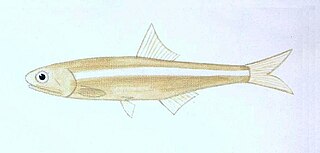
Clupeiformes is the order of ray-finned fish that includes the herring family, Clupeidae, and the anchovy family, Engraulidae and sardines. The group includes many of the most important forage and food fish.

The goldstripe sardinella or goldstripe sardine is a species of fish of the family Clupeidae. It is native to shallow tropical waters of the western Indo-Pacific, living at depths down to 70 m, and being associated with coral reefs. It grows up to 17 cm in length and forms large schools.

Tenualosa is a genus of ray-finned fish belonging to the family Dorosomatidae, which also includes the gizzard shads and sardinellas. These fishes are found in rivers, brackish waters and coasts in the Indo-Pacific region.

Escualosa is a genus of fishes in the herring family, Dorosomatidae. The genus currently contains two described species. They are found in Indo-Pacific.
Sardinella richardsoni is a species of ray-finned fish in the genus Sardinella from the South China Sea in the northwest Pacific.

Sardinella zunasi is a species of ray-finned fish in the family Clupeidae, the herrings and sardines. It is native to the northwestern Pacific Ocean, where it occurs near shore along the Asian coastlines from southern Japan to Taiwan.

Stolephorus is a genus of ray-finned fish in the family Engraulidae. They are found in Atlantic and Indo-pacific

Ilisha is a genus of ray-finned fishes in the family Pristigasteridae. The genus contains 16 species. It is similar to Pellona but lacks a toothed hypo-maxilla. The genus has a worldwide distribution in tropical and subtropical coastal waters and estuaries. Some species also enter rivers, and I. amazonica and I. novacula are largely–if not entirely–restricted to tropical rivers.

Encrasicholina is a genus of ray-finned fish in the family Engraulidae. They are widespread in the Indo-Pacific.

Amblygaster is a small genus of sardinellas in the herring family Dorosomatidae. It currently contains four species. They are found in Indo-West Pacific regions.

Herklotsichthys is a genus of herrings in the family Dorosomatidae found mostly around Southeast Asia and Australia with one species each in the Persian Gulf, the Red Sea, and the western Indian Ocean. This genus currently contains 12 species.

Amblygaster leiogaster, the smoothbelly sardinella, also known as blue sardine, blue sprat, bluebait, is a reef-associated marine species of sardinella in the herring family Clupeidae. It is one of the three species of genus Amblygaster. It is found in the marine waters along Indo-West Pacific regions south towards western Australia. The fish has 13 to 21 dorsal soft rays and 12 to 23 anal soft rays. It grows up to a maximum length of 23 cm. The flank is gold in fresh fish but becomes black while preservation. Belly is more rounded and scutes are not prominent. It is rather closely resemble Amblygaster clupeoides, but the latter has very few lower gill rakers than smoothbelly sardinella. The fish feeds on minute organisms like zooplankton.
Sardinella pacifica is a species of marine fish of the sardines in the family Clupeidae belonging to the genus Sardinella, which is endemic to the waters around the Philippines. This species was first described in 2019, with 21 preserved specimens, discovered and known only in the Philippines. It is characterized with centrally discontinuous striae in its lateral scales, dorsal fin origin with a dark spot, lower gill rakers which is more than 70 on the first gill arch, eight rays of the pelvic fin, and 17-18 prepelvic and 12-13 postpelvic scutes, all of which it closely resembled that of Sardinella fimbriata. However, the two species differs in that, S. pacifica have lower count of lateral scales, lower count of pseudobranchial filaments(14-19 compared to S. fimbriata, 19–22), postpelvic scutes(12-13 compared to S. fimbriata, 13–14), and shorter lower jaw(10.4–11.6% of standard length compared to that of S. fimbriata which is 11.1–12.2% of standard length). The fish's gill rakers was considered as the species adaptation to Philippine waters.
Stolephorus advenus, the false Indian anchovy, is a species of ray-finned fish in the family Engraulidae. It is found in the western-central Pacific Ocean.
Stolephorus dubiosus, the Thai anchovy, is a species of ray-finned fish in the family Engraulidae. It is found in the western-central Pacific Ocean.
Stolephorus multibranchus, also known as Caroline anchovy, is a species of ray-finned fish in the family Engraulidae. It is found in the western-central Pacific Ocean.
Stolephorus ronquilloi, the Ronquillo's anchovy, is a species of ray-finned fish in the family Engraulidae. It is found in the western-central Pacific Ocean.

Dorosomatidae is a family of clupeiform fishes. It is now recognized by FishBase as a family in its own right; it had been considered to be a subfamily of Clupeidae. It contains 31 extant genera.

Thrissina is a genus of anchovies in the family Engraulidae. Some authorities regard this genus as invalid, and classify the species as part of Thryssa. FishBase considers eight species as valid.

Harenngula clupeola, the false herring, false pilchard or red-ear pilchard, is a species of marine ray-finned fish belonging to the family Dorosomatidae, the gizzard shads and sardinellas. The false herring is found in the Western Atlantic Ocean from eastern Florida and the Bahamas through the Gulf of Mexico south to Santa Catarina in Brazil.















